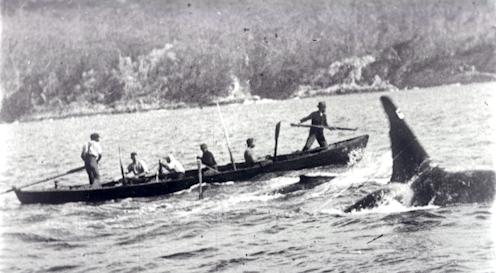For generations, killer whales and First Nations hunted whales together. Now we suspect the orca group has gone extinct
- Written by Isabella Reeves, PhD Candidate, Flinders University

For generations, the Thaua people worked with killer whales to hunt large whales in the water of Twofold Bay, on the southern coast of New South Wales. Killer whales – commonly known as orcas – would herd their giant prey into shallower waters where hunters could spear them. Humans would get the meat, but the killer whales wanted a delicacy – the tongue.
After colonists dispossessed the Thaua, Europeans began capitalising on this longstanding partnership. From around 1844, commercial whalers worked with employed Thaua and killer whales to hunt these giants. The pods of killer whales would find a prized baleen whale, herd it closer to shore and signal the whalers, who lived in the town of Eden.
The partnership has no parallel anywhere in the world: the top predator of the oceans working with the top predator on land.
One killer whale, Old Tom, became legendary due to his active role in the hunts for at least three decades. He was seven metres long and weighed six tonnes.
In 1930, he was found dead at a local beach – the last of his group in Eden. You can see his body preserved in Eden’s Killer Whale Museum. But questions have lingered. Do Old Tom’s descendants still roam the oceans, or did they die out?
Our new research suggests these famous killer whales are likely to be extinct.
Old Tom’s origins
Adaptability, cultural traditions and female-led societies have made killer whales the ultimate ocean predator. These intelligent marine mammals are the world’s largest dolphin, and the only species known to successfully hunt adult great white sharks and the world’s largest living animal – blue whales.
But different groups can live very different lives. Some are constantly on the move, while others stay living in a particular region. Some feed exclusively on one type of prey, while others feed on many. Across the globe, killer whale vocalisations differ greatly, with different dialects and languages unique to families and regions.
To find out where these killer whales of Eden came from, we drilled into one of Old Tom’s teeth and analysed the resulting powder to sequence his DNA. We used the same methods used to extract DNA from Neanderthal remains and million-year-old mammoths.
When we compared Old Tom’s DNA to a global data set of killer whales, his genome was most similar to those of modern New Zealand killer whales. He shared a most recent common ancestor with killer whales from the northern Pacific, northern Atlantic, and Australasia.
But there was no sign of any recent descendants in our modern killer whales data set. Old Tom’s DNA is mostly distinct from modern populations. That suggests the famous killers of Eden may have died out.





